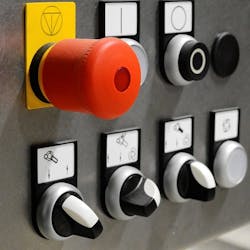Which applications can benefit from an illuminated pushbutton or indicator?
In lieu of a stacklight, what types of applications can benefit from an illuminated pushbutton or indicator??
Carter Williams, product manager, Siemens: Pilot device opportunities are everywhere. Any application that requires a motor can use a pilot device to control the motor. Adding illumination to the pushbuttons or using indicator lights also provides a visual indicator that allows the operator to monitor the status of the motor/machine from the control panel. These devices are often used to show when a machine is powered on, running, off or overload tripped. Emergency-stop pushbuttons can be illuminated to give a visual indicator when the pushbutton has been actuated. This is particularly useful in locating the source of an emergency shutdown when there are multiple emergency stop pushbuttons on the same production line. The addition of Profinet, AS-Interface or IO-Link to a pushbutton provides digital feedback. For critical processes and applications, pushbuttons with communication offer visibility down to the lowest level when incorporated into the manufacturer's network.
With safety circuits, an illuminated reset button is a good way to initialize manual resets of safety controls. Illuminated e-stop buttons provide a means of identifying which e-stops are activated when there are more than one on a machine. Stacklights augment the safety circuits by providing visual indication at a distance of e-stop and potentially reset state.
ALSO READ: Remove the Stack Lights
Mike Bacidore is the editor in chief for Control Design magazine. He is an award-winning columnist, earning a Gold Regional Award and a Silver National Award from the American Society of Business Publication Editors. Email him at [email protected].
About the Author
Mike Bacidore
Editor in Chief
Mike Bacidore is chief editor of Control Design and has been an integral part of the Endeavor Business Media editorial team since 2007. Previously, he was editorial director at Hughes Communications and a portfolio manager of the human resources and labor law areas at Wolters Kluwer. Bacidore holds a BA from the University of Illinois and an MBA from Lake Forest Graduate School of Management. He is an award-winning columnist, earning multiple regional and national awards from the American Society of Business Publication Editors. He may be reached at [email protected]

Leaders relevant to this article:














